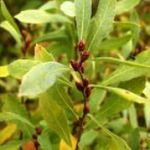| Common Name: |
Bog Myrtle |
| Other Names: |
Sweet Gale |
| Botanical Name: |
Myrica gale |
| Genus: |
Myrica |
| Family: |
Myricaceae |
| Native Location: |
Europe, Asia, and N America |
| Cultivation: |
Well-drained to wet, acid, sandy soil in sun or partial shade. Myrica gale prefers permanently wet conditions. |
| Propagation: |
By seed sown when ripe; by layering in spring; by suckers (M. gale); by semi-ripe cuttings in summer. |
| Harvest: |
Whole plants or leaves are collected during the growing season; bark and root bark in late autumn or early spring. All parts are dried for decoctions, infusions, liquid extracts, and powders. Fruits are gathered when ripe for wax extraction. |
| Height: |
1.5m (5ft) |
| Width: |
1.5m (5ft) |
| Hardiness: |
Z1-6 |
| Parts Used: |
Whole plant, leaves, fruits |
| Properties: |
A bitter, astringent, antiseptic herb with a resinous, bay-like aroma. |
| Culinary Uses: |
Leaves are infused for tea; both leaves and berries are added to soups, stews and meat dishes. Traditionally used in Yorkshire, England, as a substitute for hops to flavor ale, known as gale beer. |
| Economic Uses: |
Wax is used to make aromatic candles. |
| Bibliography: |
Encyclopedia of Herbs by Deni Brown Copyright © 1995, 2001 Dorling Kindersley Limited. pp 182-183 |

